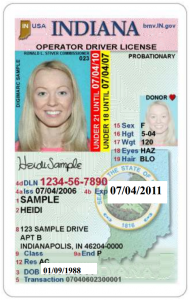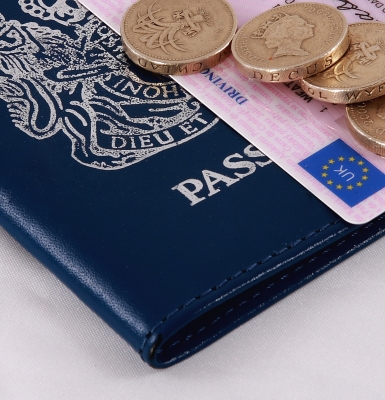The Identification Problem
ПРОБЛЕМА ИДЕНТИФИКАЦИИ
АНГЛ ЯЗЫК
Несмотря на зловещий факт, что все изобретения, связанные с электронными сетями, компьютерными системами и банковскими картами, проложили путь к Знаку зверя (см. Предыдущие разделы), будущее безналичное общество, которое возникнет в результате этих технологий, не будет казаться злом или чем-то нежелательным. Большинству потребителей уже нравится возможность мгновенного перевода электронных денежных переводов (EFT) и безналичная покупка и продажа. Долгое ожидание на кассах, которое было обычным для торговых систем с ручным управлением наличными, было значительно упрощено за счет использования компьютеров и банковских карт. Практически мгновенно новые цифровые системы могут суммировать каждую покупку, проверять счет клиента, чтобы узнать, достаточно ли у него средств, а затем переводить деньги, необходимые для любой транзакции. При этом покупателям больше не нужно приносить наличные для крупных покупок, что делает банковские карты еще более удобными. Кроме того, старый способ оплаты счетов путем выписки чеков и их отправки по почте был заменен онлайн-оплатой счетов через Интернет, которые так же просты, как ввод суммы, подлежащей оплате, и нажатие для завершения транзакции. Однако, хотя новая электронная экономика намного быстрее и кажется более безопасной, чем носить с собой наличные, у EFT есть существенные недостатки, которых не ожидалось. Наряду с удобством карточной или сетевой экономики возникло злобное чудовище, состоящее из цифровых краж и мошенничества. В этом разделе мы увидим, что эта темная сторона электронной коммерции связана с проблемой идентификации, которая со временем становится все более острой.
Наряду с переходом от наличных денег к безналичным системам с использованием чеков, кредитных и дебетовых карт возникла неожиданная потребность в проверке личности каждого человека. Этого никогда раньше не было необходимо для покупок до EFT. В экономиках, основанных на наличных деньгах, подобных тем, которые существовали тысячелетия, не было необходимости знать имя или личность покупателя. Физическая передача бумажных денег или монет в обмен на товары или услуги немедленно заверила продавца в том, что реальная стоимость будет получена в обмен на покупку. Однако теперь, когда продавцы принимают оплату с использованием заменителя наличных денег (чеки или карты), они должны быть уверены, что транзакция фактически приведет к более позднему переводу богатства (платеж по электронному переводу, осуществляемый непосредственно на счет продавца)
........
Despite the ominous fact that all the inventions related to electronic networks, computer systems, and bank cards have paved the way for the Mark of the Beast (see previous sections), the future cashless society that is resulting from these technologies will not appear evil or undesirable. The majority of consumers already love the instantaneous transfer capability of electronic funds transfer (EFT) and cashless buying and selling. The long waits at checkout counters that were common with manual cash-based commerce systems have been dramatically streamlined by the use of computers and bank cards. Almost instantly the new digital systems can add up each purchase, check the customer’s account to see if they have enough funds, and then transfer the money required for any transaction. And customers no longer have to bring cash for large purchases, which make bank cards even more convenient. In addition, the old way of paying bills by writing checks and sending them through the mail has been replaced by online Internet bill payments, which are as simple as filling in an amount to be paid and clicking to complete the transaction. However, while the new electronic economy is much faster and seemingly more secure than carrying around cash, there are significant downsides to EFT that were not expected. Alongside the convenience of a card-based or Web-based economy, there has arisen an evil monster consisting of digital theft and fraud. In this section we will see that this dark side of electronic commerce is associated with an identification problem that is becoming much more acute as time goes on.
Along with the transition from cash to cashless systems involving checks, credit cards, and debit cards there has arisen an unexpected need to verify the identity of every person. This has never before been necessary for any purchases before the time of EFT. In cash-based economies like those that have existed for millennia, there was no need to know the buyer’s name or identity. The physical transfer of paper money or coins in exchange for goods or services immediately assured a seller that real value would be received in return for the purchase. However, now when sellers accept payment using a substitute for cash (checks or cards), they have to trust that the transaction will actually result in the later transfer of wealth (an EFT transfer payment made directly into the seller’s account).
But what if the buyer is using stolen checks or counterfeit cards along with fake identification to make a purchase? Stolen credit cards are used every day to illegally purchase items in stores or online. Many merchants don’t even require other forms of identification, thus making fraudulent use of cards even easier. Debit cards were designed to be more secure than credit cards because of the requirement to enter a PIN, but they are also subject to being lost or stolen and used fraudulently. Thieves have been known to place skimmers over the insert slot on ATM machines or on gas station pumps to capture the debit card number and PIN as customers use them. Every card number and PIN captured by such skimmers can then be used to make a counterfeit card and subsequently used to buy items anywhere the thief desires. In addition, if your debit card is lost or stolen and somehow the thief gets to know your PIN, then your account can be accessed at ATMs without your permission. Incredibly, some people have even been known to even write their PIN on their card, thus guaranteeing a thief would be able to use it. In other words, even with the advent of the supposedly more secure features of debit cards, fraud can still occur.
The fact is the transition from the use of tangible cash having inherent face value to an electronic economy using cash substitutes has created a need to know everyone’s identity with certainty. In an EFT system, the only way a seller can be assured that a buyer has the funds to cover a purchase is if the buyer’s true identity can be established and the network then can be used to verify the required funds are present in buyer’s account.
 Unfortunately, all the security measures that have been developed still do not prevent fraud. As a retailer, how can you be certain that the individual standing in front of you is really the person he claims to be and that he or she has the money to cover a purchase? Even with EFT systems operating with coded ATM or debit cards, identity fraud is still a constant concern. Anyone can steal a purse or a wallet, obtain another person’s credit or debit card, and go on a cashless buying binge. The same is true for stolen checks. At least for a few hours or a few days, a dishonest person can get away with buying almost anything his heart desires with stolen checks or cards.
Unfortunately, all the security measures that have been developed still do not prevent fraud. As a retailer, how can you be certain that the individual standing in front of you is really the person he claims to be and that he or she has the money to cover a purchase? Even with EFT systems operating with coded ATM or debit cards, identity fraud is still a constant concern. Anyone can steal a purse or a wallet, obtain another person’s credit or debit card, and go on a cashless buying binge. The same is true for stolen checks. At least for a few hours or a few days, a dishonest person can get away with buying almost anything his heart desires with stolen checks or cards.
However, even more troublesome than stealing an individual card or checkbook is the type of fraud known as identity theft. Criminals are more intent on stealing someone’s identity then they are in stealing someone’s card. Someone with access to another person’s Social Security Number or other key personal information can then open bank accounts and get credit or debit cards in the other person’s name. This is the worst form of theft, because a stolen identity can result in years of fraudulent purchases that can destroy the finances and credit rating of the real individual.
In an evil world, it is not surprising that identity theft has grown concurrent with the growth in cashless buying and selling. In the developed world, identity theft and credit card fraud have cost consumers billions of dollars in losses each year. In the U.S. alone there was $190 billion in credit card losses during 2011 (Haydn Shaughnessy, Solving the $190 billion annual fraud problem, Forbes online). This figure does not include losses due to other forms of theft, such as debit cards and checks. Organized groups of computer hackers are constantly involved in trying to break into secure servers on the Internet to capture personal information, credit card numbers, and Social Security Numbers. Their efforts have resulted in numerous security breaches at major retailers and financial institutions along with the illegal downloading of millions of consumer financial records. In early October 2013, a breach occurred on Adobe’s web site as hackers gained access to nearly 3 million customer records, including their IDs, passwords, and credit card information (Huffington Post). The sale of such records results in the potential identity theft and financial liability for millions of individuals and companies, and such losses are increasing at over 20% per year. In the U.S. alone the number of consumers reporting identity theft and fraud during 2010 was an incredible 32% (Consumer Reports, June 2011).
Of course it is true that if the loss of a credit card, debit card, or checkbook is reported immediately, all the true owner is liable for is about $50; however, if a fraudulent purchase really does occur, then the financial institution or retailer are still responsible for the rest of the loss (note: liability varies depending on the account agreement and on the individual laws of each country). Even with this limited liability, the total financial load on the global economic system due to identity theft and fraud is substantial, with the rate of growth accelerating every year as computer hacking software and thieves are becoming more sophisticated.
These problems are putting pressure on the entire global financial system to improve its security and eliminate fraud altogether. To bring more security and certainty into EFT transactions there is a growing need to establish the identity of every person on an absolute basis. It is not enough just to have an activated card or a check with an active account number on it. To eliminate identity fraud, society is looking toward new technology options that will verify who a person is and thus prevent this type of theft in the future.
The most important consideration in using electronic transactions in a cashless economy is not only whether customers can cover a purchase by proving they have sufficient funds in their account, but whether the correct identity of the customer can be established so fraud cannot occur. It seems that the only way to really stop scams in an environment of buying and selling without cash is to be absolutely certain who the customer really is. This need for identification is real whether a customer is writing a check to cover a purchase, using a credit or debit card, or using electronic means. Only by absolutely confirming identity is it possible to know for certain that a buyer is actually taking personal responsibility for a purchase and using their own account to pay for the transaction. Without a viable system to enable this security, fraud and identity theft will continue to plague the economy of the world.
It is interesting to note, however, that it is only in the case where a person uses cash to buy something that complete identification is not necessary. Thus, the trend toward cashless buying and selling has created a situation that was never before important in any economic system. In the past, if one person had something for sale and another person had the cash to buy it, it wouldn’t matter who the buyer was so long as he or she had the money to pay for it. As soon as the seller had the money in his hands, he could be assured that he had something of value in exchange for the item he was selling. This is the fundamental principle of fair exchange that has been the basis for all commerce throughout much of civilized history. However, with the movement toward cashless buying and selling, whether originating by check, credit card, debit card, ATM technology, or through POS terminals, the problem with fraud has made merchants and financial institutions almost paranoid over identification.
This paranoia is completely justified. Computer graphics along with printer and scanner capabilities have so helped counterfeiters that bogus cards with valid numbers are constantly surfacing. Credit card companies have tried to thwart the problem by using lasers to etch three-dimensional holograms on the front of their cards. However, even holograms on some cards are being accurately duplicated by counterfeiters, which makes it extraordinarily difficult to determine the validity of cards just by looking at them. And you certainly can’t confirm a person’s identity just by looking at the name on a card.
The problem of personal identification has become even more critical due to the dangers of terrorism that suddenly expanded to an international level after 9-11. The threat of terrorism as well as the trafficking in illicit materials and weapons has so endangered the world that extraordinary pressure is being placed on the international community to put a stop to them. The response of the world after 9-11 was to dramatically raise the level of security for all public activities, especially in the realm of financial transactions and travel. Government agencies in every country have been involved in developing enhanced security policies and technologies, which include better methods of personal identification and surveillance. As a result of these activities, new methods for verifying identity have been deployed, including the use of microprocessor-based cards that are capable of RFID communications and contain biometric identifiers. Today, almost every country has introduced national ID cards with these features, and international standards have been developed to make them useable in any region of the world.
Knowing the correct identity of every person and being able to track and surveil them anywhere in the world is the new major trend of the Twenty-First Century. In the coming sections, these new technologies will be reviewed in great detail, and it will quickly become obvious how they will fit into the rise of the last world empire and the coming of the Antichrist’s economic system. As the Mark of the Beast looms closer, personal identification is going to be the most critical problem to solve in making its coming possible. Eventually, when everyone is issued a final, universal EFT card as a prelude to the Mark (that day is almost upon us), the need to have a definitive method of identification will become paramount. We will soon see that as the Empire of the Beast arises and develops its economic system, it will move closer and closer to the actual system that the Antichrist will use at the end.
It is fascinating how the prophecy of the Mark of the Beast in Revelation (Rev. 13:16-18) indicates that the economy of the Antichrist will require three things to buy or sell: 1) the Mark of the Beast, 2) the number of the Beast, and 3) the name of the Beast. Is it just a coincidence that two of these three requirements are a part of the electronic commerce systems today—the use of an authorized name and a number? Your name is your confirmed or proper identity and your number is your account number, which is associated with a particular check or card that you might use. As we will soon see, however, in the final system of the Antichrist these same parameters will be present but augmented with a third important feature. The system of the Beast will still involve the use of your name and a final authorized number, but in addition it will add the Mark of the Beast in the right hand or forehead. All three of these parameters will be used to confirm a person’s identity and allow them to participate in society. Thus, the final economic system will eliminate fraud by definitively linking to each individual an authorized identity (name), a personal and unique number, and a Mark as distinctive identifiers. All three of these factors will be needed by everyone in order to buy and sell in the Empire of the Beast!


